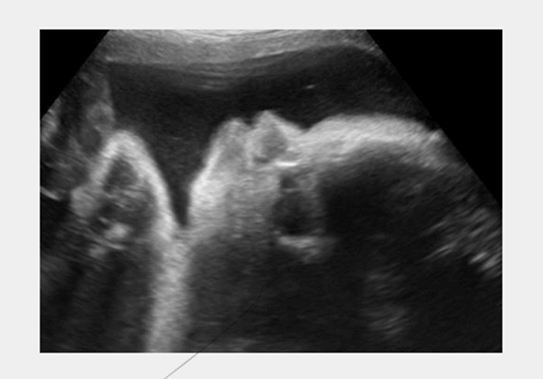
What is an ultrasound?
- Ultrasound (also called sonography or ultrasonography) is a noninvasive imaging test. An ultrasound picture is called a sonogram. Ultrasound uses high-frequency sound waves to create real-time pictures or video of internal organs or other soft tissues, such as blood vessels.
- Ultrasound enables healthcare providers to “see” details of soft tissues inside your body without making any incisions (cuts). And unlike X-Ray, ultrasound doesn’t use radiation.
- Although most people associate ultrasound with pregnancy, healthcare providers use ultrasound for many different situations and to look at several different parts of the inside of your body.
What are the different kinds of ultrasounds?
- There are three main categories of ultrasound imaging, including:
- Pregnancy ultrasound (prenatal ultrasound).
- Diagnostic ultrasound.
- Ultrasound guidance for procedures.
Pregnancy ultrasound
- Healthcare providers often use ultrasound (often called prenatal or obstetric ultrasound) to monitor you and the fetus during pregnancy.
- Providers use prenatal ultrasound to:
- Confirm that you’re pregnant.
- Check to see if you’re pregnant with more than one fetus.
- Estimate how long you’ve been pregnant and the gestational age of the fetus.
- Check the fetal growth and position.
- See the fetal movement and heart rate.
- Check for congenital conditions (birth defects) in the fetal brain, spinal cord, heart or other parts of its body.
- Check the amount of amniotic fluid.
- Most healthcare providers recommend an ultrasound at 20 weeks pregnant. This test tracks the fetus’s growth and development during pregnancy. This ultrasound may also show the biological sex of the fetus. Tell your technician if you do or do not want to know the sex.
- Your provider may order extra scans to get answers to any questions or concerns, such as the potential for congenital conditions.
Diagnostic ultrasound
Providers use diagnostic ultrasounds to view internal parts of your body to see if something is wrong or not working properly. They can help your provider learn more about what’s causing a wide range of symptoms, such as unexplained pain, masses (lumps) or what may be causing an abnormal blood test.
For most diagnostic ultrasound exams, the technician places the transducer (probe) on your skin. In some cases, they may need to place the probe inside your body, such as in your vagina or rectum.
The type of diagnostic ultrasound you have depends on the details of your case.
Examples of diagnostic ultrasounds include:
Abdominal ultrasound: An ultrasound probe moves across the skin of your midsection (belly) area. Abdominal ultrasound can diagnose many causes of abdominal pain.
Kidney (renal) ultrasound: Providers use kidney ultrasound to assess the size, location and shape of your kidneys and related structures, such as your ureters and bladder. Ultrasound can detect cysts, tumors, obstructions or infections within or around your kidneys.
Breast ultrasound: A breast ultrasound is a noninvasive test to identify breast lumps and cysts. Your provider may recommend an ultrasound after an abnormal mammogram.
Doppler ultrasound: This is a special ultrasound technique that assesses the movement of materials, like blood, in your body. It allows your provider to see and evaluate blood flow through arteries and veins in your body. Doppler ultrasound is often used as part of a diagnostic ultrasound study or as part of a vascular ultrasound.
Pelvic ultrasound: A pelvic ultrasound looks at the organs in your pelvic area between your lower abdomen (belly) and legs. Some of the pelvic organs include your bladder, prostate, rectum, ovaries, uterus and vagina.
Transvaginal ultrasound: Your provider inserts a probe into your vaginal canal. It shows reproductive tissues such as your uterus or ovaries. A transvaginal ultrasound is sometimes called a pelvic ultrasound because it evaluates structures inside your pelvis (hip bones).
Thyroid ultrasound: Providers use ultrasound to assess your thyroid, a butterfly-shaped endocrine gland in your neck. Providers can measure the size of your thyroid and see if there are nodules or lesions within the gland.
Transrectal ultrasound: Your provider inserts an ultrasound probe transducer into your rectum. It evaluates your rectum or other nearby tissues, such as the prostate in people assigned male at birth.
Why an ultrasound is performed
- Most people associate ultrasound scans with pregnancy. These scans can provide an expectant mother with the first view of her unborn child. However, the test has many other uses.
- Your doctor may order an ultrasound if you’re having pain, swelling, or other symptoms that require an internal view of your organs. An ultrasound can provide a view of the:
- bladder
- brain (in infants)
- eyes
- gallbladder
- kidneys
- liver
- ovaries
- pancreas
- spleen
- thyroid
- testicles
- uterus
- blood vessels
- An ultrasound is also a helpful way to guide surgeons’ movements during certain medical procedures, such as biopsies.
How an ultrasound is performed
- Before the exam, you will change into a hospital gown. You will most likely be lying down on a table with a section of your body exposed for the test.
- An ultrasound technician, called a sonographer, will apply a special lubricating jelly to your skin. This prevents friction so they can rub the ultrasound transducer on your skin. The transducer has a similar appearance to a microphone. The jelly also helps transmit the sound waves.
- The transducer sends high-frequency sound waves through your body. The waves echo as they hit a dense object, such as an organ or bone. Those echoes are then reflected back into a computer. The sound waves are at too high of a pitch for the human ear to hear. They form a picture that can be interpreted by the doctor.
- Depending on the area being examined, you may need to change positions so the technician can have better access.
- After the procedure, the gel will be cleaned off of your skin. The whole procedure typically lasts less than 30 minutes, depending on the area being examined. You will be free to go about your normal activities after the procedure has finished.
The Difference Between 2D, 3D, 4D, HD and 5D Ultrasounds
If you are expecting, it can be hard to navigate the many different types of ultrasounds that can be done during pregnancy.
While all ultrasounds use soundwaves to ultimately create a picture of your developing baby, the finished product can range widely depending on the definition type that you choose. To help make the decision easier, Anticipation Ultrasound Studio is here to explain the difference between 2D, 3D, 4D, HD, and 5D ultrasounds.

2D Ultrasounds
As the most common form of ultrasound, a 2D ultrasound creates a black and white image that shows the skeletal structure of the baby and makes the internal organs visible. The 2D ultrasound is most commonly used to diagnosis the health of the baby. As the name implies, all 2D images are flat and have no depth to them.

3D Ultrasounds
Much like 2D ultrasounds, a 3D ultrasound uses soundwaves to develop an image of the baby inside of your womb. However, unlike the flat image given by a 2D ultrasound, a 3D ultrasound creates the appearance of a three-dimensional image of the baby. This allows the expecting parents to see their baby’s face, rather than just the outline of the face.

4D Ultrasounds
4D ultrasounds also create a three-dimensional image but provide the benefit of creating an effect like a live video. With this type of ultrasound, you could potentially see your baby smile or yawn in the womb because it compiles hundreds of images into a moving video.

HD, HD Live, 5D Ultrasounds
As the most recent advancement in ultrasound technology, HD and HD Live (also called 5D ) ultrasounds allow us to capture even clearer, sharper images. These images are more defined and have better resolution.

